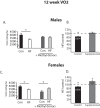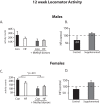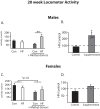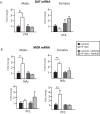Methyl donor supplementation blocks the adverse effects of maternal high fat diet on offspring physiology
- PMID: 23658839
- PMCID: PMC3642194
- DOI: 10.1371/journal.pone.0063549
Methyl donor supplementation blocks the adverse effects of maternal high fat diet on offspring physiology
Abstract
Maternal consumption of a high fat diet during pregnancy increases the offspring risk for obesity. Using a mouse model, we have previously shown that maternal consumption of a high fat (60%) diet leads to global and gene specific decreases in DNA methylation in the brain of the offspring. The present experiments were designed to attempt to reverse this DNA hypomethylation through supplementation of the maternal diet with methyl donors, and to determine whether methyl donor supplementation could block or attenuate phenotypes associated with maternal consumption of a HF diet. Metabolic and behavioral (fat preference) outcomes were assessed in male and female adult offspring. Expression of the mu-opioid receptor and dopamine transporter mRNA, as well as global DNA methylation were measured in the brain. Supplementation of the maternal diet with methyl donors attenuated the development of some of the adverse effects seen in offspring from dams fed a high fat diet; including weight gain, increased fat preference (males), changes in CNS gene expression and global hypomethylation in the prefrontal cortex. Notable sex differences were observed. These findings identify the importance of balanced methylation status during pregnancy, particularly in the context of a maternal high fat diet, for optimal offspring outcome.
Conflict of interest statement
Figures







Similar articles
-
Protective effects of maternal methyl donor supplementation on adult offspring of high fat diet-fed dams.J Nutr Biochem. 2016 Aug;34:42-51. doi: 10.1016/j.jnutbio.2016.04.005. Epub 2016 Apr 27. J Nutr Biochem. 2016. PMID: 27183114
-
Methyl donor supplementation alters cognitive performance and motivation in female offspring from high-fat diet-fed dams.FASEB J. 2017 Jun;31(6):2352-2363. doi: 10.1096/fj.201601172R. Epub 2017 Feb 16. FASEB J. 2017. PMID: 28209774 Free PMC article.
-
Maternal high-fat diet alters methylation and gene expression of dopamine and opioid-related genes.Endocrinology. 2010 Oct;151(10):4756-64. doi: 10.1210/en.2010-0505. Epub 2010 Aug 4. Endocrinology. 2010. PMID: 20685869 Free PMC article.
-
Maternal methyl donor supplementation: A potential therapy for metabolic disorder in offspring.J Nutr Biochem. 2024 Feb;124:109533. doi: 10.1016/j.jnutbio.2023.109533. Epub 2023 Nov 15. J Nutr Biochem. 2024. PMID: 37977406 Review.
-
Effects of high-fat diet exposure on learning & memory.Physiol Behav. 2015 Dec 1;152(Pt B):363-71. doi: 10.1016/j.physbeh.2015.06.008. Epub 2015 Jun 9. Physiol Behav. 2015. PMID: 26066731 Free PMC article. Review.
Cited by
-
Maternal methyl donor supplementation regulates the effects of cafeteria diet on behavioral changes and nutritional status in male offspring.Food Nutr Res. 2023 Oct 27;67. doi: 10.29219/fnr.v67.9828. eCollection 2023. Food Nutr Res. 2023. PMID: 37920679 Free PMC article.
-
Maternal obesity, inflammation, and developmental programming.Biomed Res Int. 2014;2014:418975. doi: 10.1155/2014/418975. Epub 2014 May 20. Biomed Res Int. 2014. PMID: 24967364 Free PMC article. Review.
-
Interplay between Metabolism, Nutrition and Epigenetics in Shaping Brain DNA Methylation, Neural Function and Behavior.Genes (Basel). 2020 Jul 3;11(7):742. doi: 10.3390/genes11070742. Genes (Basel). 2020. PMID: 32635190 Free PMC article. Review.
-
Sugar Addiction: From Evolution to Revolution.Front Psychiatry. 2018 Nov 7;9:545. doi: 10.3389/fpsyt.2018.00545. eCollection 2018. Front Psychiatry. 2018. PMID: 30464748 Free PMC article. Review.
-
Exposure of neonatal rats to maternal cafeteria feeding during suckling alters hepatic gene expression and DNA methylation in the insulin signalling pathway.Genes Nutr. 2014 Jan;9(1):365. doi: 10.1007/s12263-013-0365-3. Epub 2013 Dec 20. Genes Nutr. 2014. PMID: 24357221 Free PMC article.
References
-
- Brawarsky P, Stotland NE, Jackson RA, Fuentes-Afflick E, Escobar GJ, et al. (2005) Pre-pregnancy and pregnancy-related factors and the risk of excessive or inadequate gestational weight gain. Int J Gynaecol Obstet 91: 125–131. - PubMed
-
- Schack-Nielsen L, Michaelsen KF, Gamborg M, Mortensen EL, Sørensen TI (2010) Gestational weight gain in relation to offspring body mass index and obesity from infancy through adulthood. Int J Obes (Lond) 34: 67–74. - PubMed
Publication types
MeSH terms
Grants and funding
LinkOut - more resources
Full Text Sources
Other Literature Sources
Medical
Research Materials
Miscellaneous

